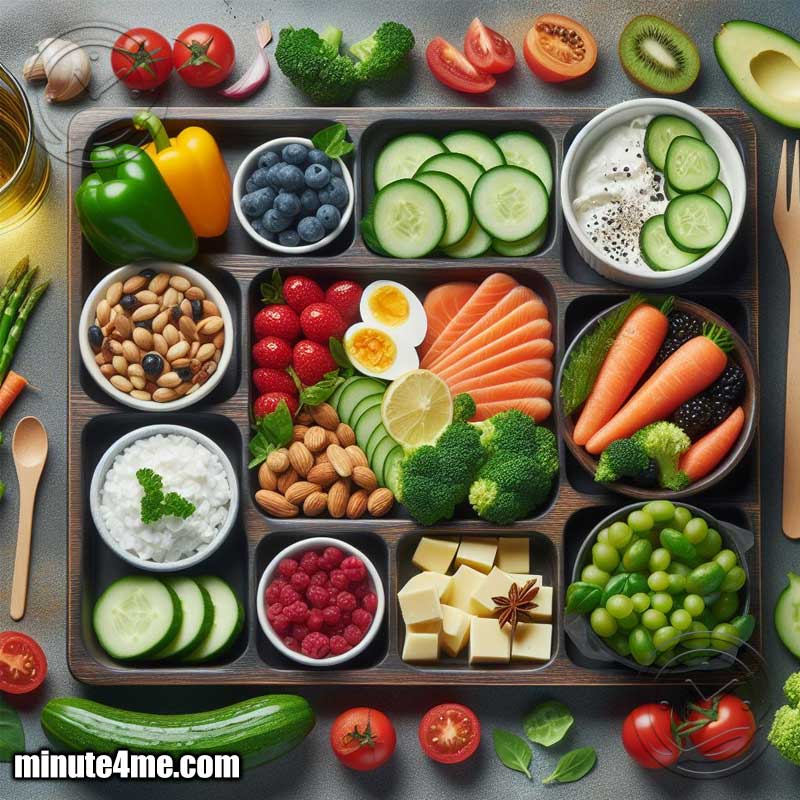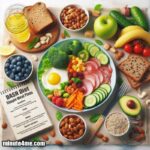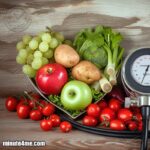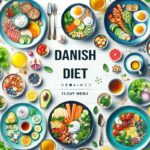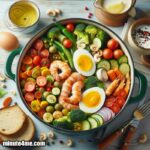Understanding the DASH Diet
The core of the DASH diet is its focus on reducing sodium intake while promoting the consumption of fruits, vegetables, whole grains, and lean proteins.
It’s designed to be rich in fiber, potassium, magnesium, and calcium – nutrients that are essential for heart health.
The goal is to limit sodium, added sugars, and unhealthy fats, which can contribute to hypertension and heart disease.
Essential DASH Diet Food Groups
The foundation of the DASH diet lies in its strategic emphasis on certain food groups, each contributing uniquely to heart health and blood pressure management.
Here’s a closer look at these essential categories:
Fruits and Vegetables
These are the cornerstone of the DASH diet, offering a rich source of potassium, magnesium, fiber, and antioxidants which are vital for maintaining healthy blood pressure levels and overall heart health. Aim for 4-5 servings of each per day.
Fruits: Opt for a variety of colors and types, such as berries, citrus fruits, apples, and melons.
Vegetables: Include leafy greens, such as spinach and kale, along with red and orange vegetables like carrots and peppers.
Whole Grains
Consuming whole grains is crucial for heart health due to their high fiber content, which can help lower cholesterol and improve heart health. Target at least 3-4 servings per day.
Examples: Brown rice, whole wheat bread, quinoa, and oatmeal.
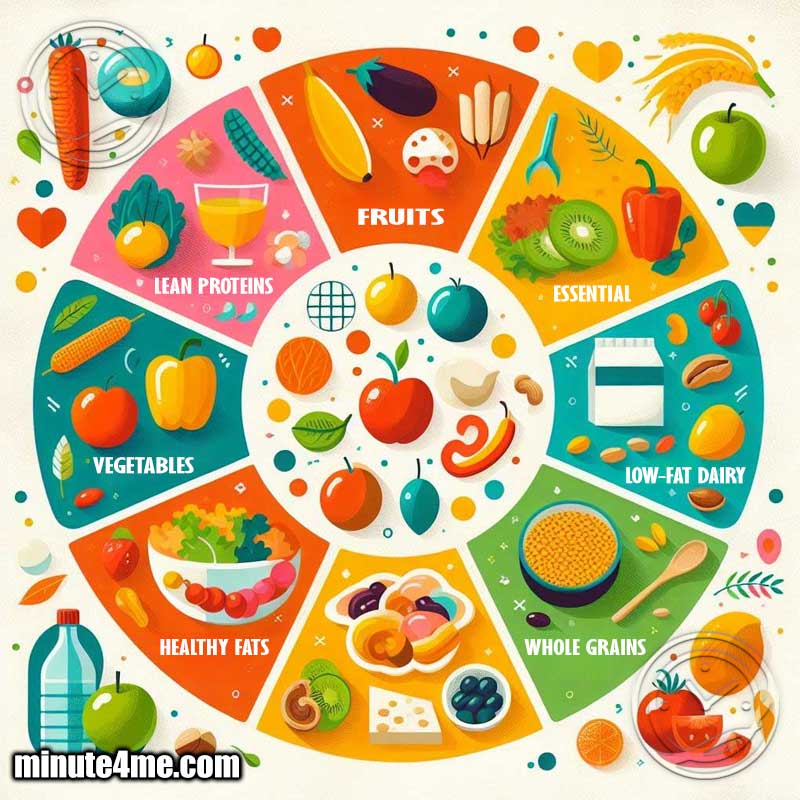
Low-Fat Dairy
These products provide calcium, vitamin D, and protein without the added saturated fat of their full-fat counterparts. 2-3 servings per day are recommended.
Options: Skim or 1% milk, low-fat yogurt, and low-fat cheese.
Lean Proteins
Lean protein sources such as fish, poultry, beans, and nuts are low in saturated fat and high in essential nutrients. They play a key role in muscle repair and heart health.
Servings: Aim for 6 ounces or less per day, focusing on variety and preparation methods that do not add extra fat or sodium.
Healthy Fats
Despite the DASH diet’s low-fat approach, it recognizes the importance of healthy fats in moderation, particularly those rich in omega-3 fatty acids, for heart health.
Sources: Avocado, olive oil, and fatty fish like salmon.
Unlock the gateway to vibrant health with the DASH Diet Food List Guide. Imagine a life where your heart sings…
Breakfasts
A nutritious breakfast sets the tone for the day, offering the energy and nutrients needed to start your morning right.
Here are detailed breakfast ideas that align with the DASH diet:
Oatmeal with Berries and Nuts
Prepare with 1 cup of oatmeal, topped with a handful of mixed berries (blueberries, strawberries) and a sprinkle of almonds or walnuts for added omega-3 fatty acids.
Whole-Wheat Toast with Avocado and Eggs
Use one slice of whole-wheat toast, spread with half an avocado, and serve with two eggs cooked to your preference. This meal provides a good balance of fiber, healthy fats, and protein.
Greek Yogurt with Fruit and Granola
Combine 1 cup of low-fat Greek yogurt with a variety of fresh fruits and a sprinkle of low-sugar granola. This option is rich in protein, calcium, and fiber.
Lunch Ideas
Lunch on the DASH diet can be both satisfying and nutritious, incorporating a variety of food groups.
Here are some ideas:
Salad with Grilled Chicken or Fish, Beans, and Vegetables
Mix leafy greens with grilled chicken or fish (salmon or tuna), add a half-cup of beans (chickpeas or black beans), and top with a variety of vegetables like tomatoes, cucumbers, and carrots. Dress with a vinaigrette made from olive oil and lemon juice for a dose of healthy fats.
Lentil Soup with Whole-Wheat Bread
A bowl of lentil soup accompanied by a slice of whole-wheat bread makes for a fiber-rich meal that’s also packed with protein and essential nutrients.
Unlock the secret to a heart-healthy lifestyle with our DASH Diet Simple Meal Plans. This guide offers a seamless way…
Dinners
Dinner is a perfect time to experiment with DASH diet recipes that are both wholesome and delicious.
Here are some ideas to get you started:
Grilled Fish with Roasted Vegetables
Choose fatty fish like salmon for omega-3 fatty acids and serve with a side of roasted vegetables such as broccoli, bell peppers, and sweet potatoes. This combination offers a wealth of nutrients, including fiber, vitamins, and healthy fats.
Chicken Stir-Fry with Brown Rice
Use lean chicken breast and a variety of colorful vegetables (snap peas, carrots, bell peppers) stir-fried in a minimal amount of olive oil. Serve over a bed of brown rice for a well-rounded meal that includes lean protein, whole grains, and a range of vitamins.
Snacks
Smart snacking is an integral part of the DASH diet, helping to keep hunger at bay while providing essential nutrients without overloading on sodium.
Here are some DASH-friendly snack ideas that are both nutritious and satisfying:
- Fruits and Vegetables with Hummus: Combine slices of cucumber, bell peppers, or carrots with a small portion of hummus for a snack rich in fiber and protein.
- Nuts and Seeds: A small handful of unsalted almonds, walnuts, or sunflower seeds can provide a good source of healthy fats and protein, making them an ideal snack.
- Low-fat Yogurt: Opt for a cup of low-fat or Greek yogurt. Add a sprinkle of cinnamon or mix with fresh fruit for added flavor without the added sugar.
- Whole Grain Crackers with Avocado: Spread a thin layer of mashed avocado on whole-grain crackers. This snack offers a good balance of healthy fats, fiber, and complex carbohydrates.
Snack Planning Tips:
- Portion Control: Keep an eye on portion sizes to avoid overeating.
- Variety: Rotate between different snacks to ensure a wide range of nutrients.
- Preparation: Prepare snacks in advance to avoid the temptation of high-sodium, processed options.
DASH Diet and High Blood Pressure – Hypertension
Discover the life-changing DASH Diet, a revolutionary approach to conquering hypertension, the silent threat that affects millions worldwide. This meticulously…
Tips for Reducing Sodium in Meals
Reducing sodium intake is a cornerstone of the DASH diet.
Here are practical strategies to lower sodium without compromising on taste:
- Use Herbs and Spices: Enhance flavor with a variety of herbs and spices like garlic, basil, cumin, and chili flakes instead of salt.
- Choose Fresh or Frozen Vegetables: Opt for fresh or frozen vegetables over canned versions, which often contain added sodium.
- Read Labels: Pay close attention to nutrition labels and choose products with lower sodium content.
- Rinse Canned Goods: If using canned beans or vegetables, rinse them under water to remove excess sodium.
- Cook from Scratch: Prepare meals at home where you have control over the amount of salt added.
| High-Sodium Food | Lower-Sodium Alternative |
|---|---|
| Canned Soups | Homemade soups |
| Processed Meats | Fresh poultry or fish |
| Salted Nuts | Unsalted nuts |
| Store-Bought Sauces | Homemade sauces |
| Regular Bread | Low-sodium bread |
Planning Your DASH Diet Meal Plan
Creating a meal plan is crucial for successfully following the DASH diet.
It helps ensure a balanced intake of nutrients while managing sodium and calorie intake.
Here’s how to plan effectively:
- Determine Caloric Needs: Your calorie intake depends on age, sex, weight, and activity level. Understanding this will guide your portion sizes and meal choices.
- Incorporate All Food Groups: Make sure each meal contains a mix of fruits, vegetables, whole grains, lean proteins, and low-fat dairy to meet nutritional needs.
- Plan Snacks: Include healthy snacks to prevent hunger and overeating at meal times.
- Prepare in Advance: Meal prep can save time and reduce the temptation to opt for high-sodium, processed foods.
| Time of Day | Meal Options |
|---|---|
| Breakfast | Oatmeal with berries and nuts |
| Lunch | Grilled chicken salad with beans |
| Snack | Carrots and hummus |
| Dinner | Salmon with roasted vegetables |
| Snack | A small serving of unsalted nuts |
Benefits
Adhering to the DASH diet has numerous health benefits, substantiated by research:
- Lower Blood Pressure: The diet is effective in reducing blood pressure, crucial in preventing heart disease and stroke.
- Improved Heart Health: By limiting unhealthy fats and cholesterol, the DASH diet can help reduce the risk of heart disease.
- Weight Management: High in fiber and protein, it can help in weight loss and maintenance by keeping you feeling fuller longer.
- Diabetes Management: The focus on whole grains and fiber can help regulate blood sugar levels, beneficial for those with diabetes.
Key Health Benefits:
- Reduction in hypertension risk
- Lowered cholesterol levels
- Improved insulin sensitivity
- Enhanced overall cardiovascular health
Conclusion
The DASH diet is more than just a diet; it’s a sustainable, enjoyable way of eating that supports long-term health.
By focusing on whole, nutrient-rich foods, you can enjoy delicious meals that are good for your heart and your overall health.
Experiment with different recipes and flavors within the DASH diet guidelines to find what works best for you, and remember, small changes can make a big difference in your health.
